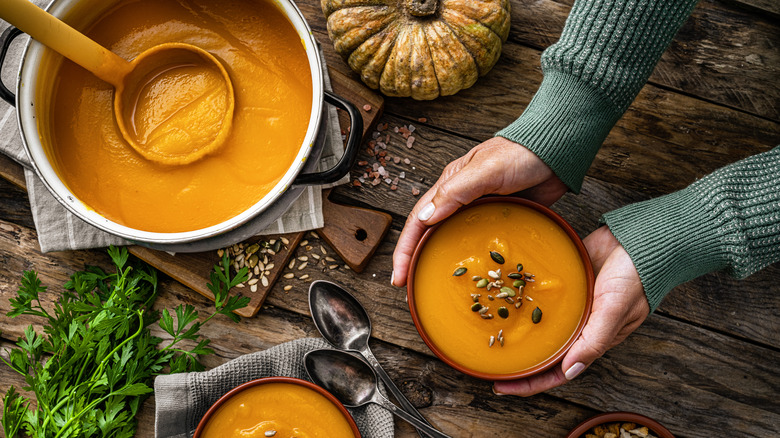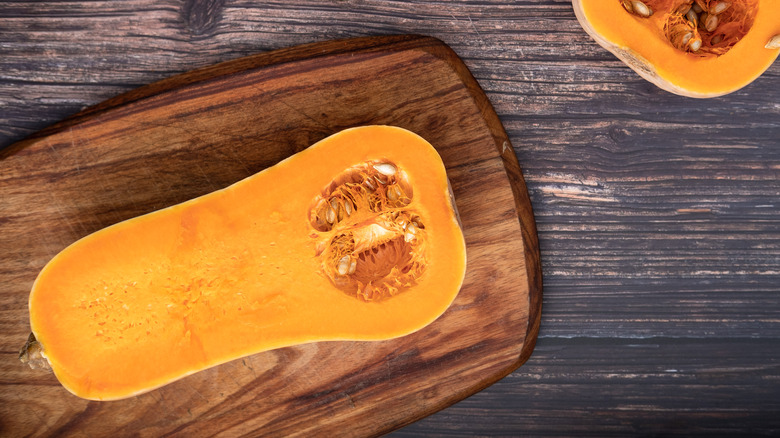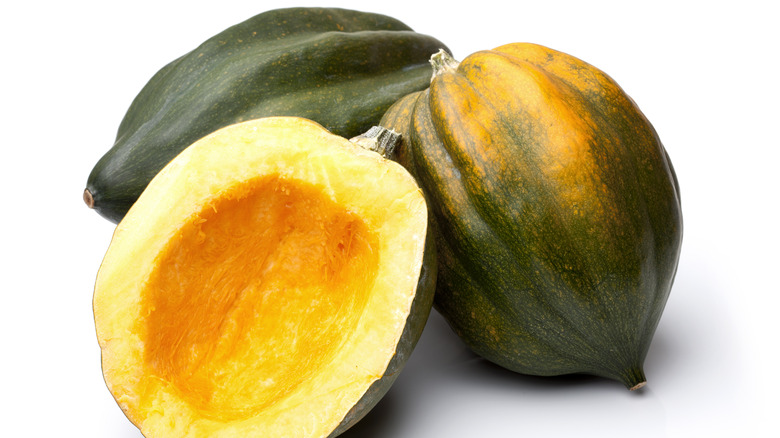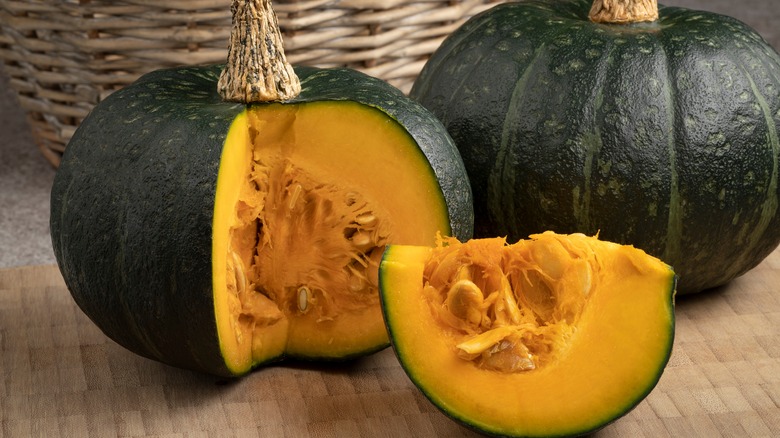The Absolute Best Squash Varieties To Replace Pumpkin In Soup
Pumpkins are the harbingers of fall, carved into jack-o-lanterns for Halloween, appearing as colorful centerpieces on our Thanksgiving tables, and inspiring seasonal lattes, desserts, and savory side dishes. As a hearty winter squash, pumpkins have hard shells with thick, meaty linings that you can roast like a root vegetable to bring out a sumptuous caramelization and starchy, fluffy texture. And after pumpkin pie and pumpkin spice lattes, soup is one of the most popular and simple pumpkin recipes. A blend of pureed pumpkin, cream, and spices makes for the ultimate fall comfort food.
But pumpkin is just one of the many types of squash available during the fall season. If your local grocery store is out of fresh pumpkin or you're averse to using canned pumpkin puree, you can take advantage of other squash varieties to replace pumpkin in soup. While the exact type of squash you use is up to personal preference, arguably the best varieties for a pumpkin substitute are butternut, acorn, and kabocha squash. These three varieties come the closest to pumpkin's texture, flavor, and peak seasonal availability — though a closer look at each squash reveals a few adjustments you might want to make to your recipe if you're using them as a substitute.
Butternut squash
Named for its creamy texture and nutty, rich flavor, butternut squash is a common pumpkin substitute because it mimics the texture, color, and taste of pumpkin, and it's available year-round. Consequently, you can enjoy butternut squash soup in the spring or summer just as easily as in the fall.
When roasted, butternut squash is as sweet and starchy as sweet potato, and many pumpkin soup recipes even use a blend of pumpkin and butternut squash puree. As a bonus, butternut squash are typically smaller than pumpkins but have a much higher flesh-to-seed ratio.
The preparation of butternut squash is roughly the same as pumpkin, requiring you to split the squash in half, scrape out the seeds and fibers, drizzle with oil, and bake until tender. But unlike pumpkin and acorn squash, you don't need to remove the skin of butternut squash for a puree — you can simply throw the entire squash into a food processor after roasting it. As a replacement for pumpkin in soup, you can also use the same proportions of butternut squash.
Acorn squash
Acorn squash looks like a dark green miniature pumpkin, with the same orange-hued interior and slightly more meat. They make beautiful individual-sized stuffed squash boats or sweet side dishes to smother with butter and cinnamon, but they also make good substitutes for pumpkin in soup. While you might find acorn squash year-round, they're a winter squash with optimal flavor between October and December.
Acorn squash meat is more fibrous than pumpkin, with a stringier, slightly more watery consistency, but pureeing it minimizes textural differences. However, acorn squash has a much milder butteriness and is less sweet than pumpkin. You'll use the same amount of acorn squash puree as pumpkin puree in pumpkin soup, but to compensate for a milder flavor profile, you can roast acorn squash with butter, cinnamon, and brown sugar before pureeing it. You can also add maple syrup and a splash of extra heavy cream to the soup. Another option that will amp up the sweetness, nuttiness, and thickness of acorn squash soup is coconut cream or a blend of coconut cream and full-fat coconut milk.
Kabocha squash
A Japanese cultivar, kabocha squash is often referred to as a Japanese pumpkin. This variety is dark green with light orange meat and looks like a slightly wider, squatter pumpkin. Unlike pumpkin and acorn squash, kabocha squash has very thin, edible skin. It's one of the richest squash varieties with a pillowy, fluffy texture that's reminiscent of a chestnut and a sweet, creamy flavor profile, making it a perfect substitute for pumpkin if you like your soup on the sweeter side.
The kabocha squash's density and low water content also make it luxurious as a sweet potato substitute and a popular dessert ingredient in Southeast Asian custards; it's similarly popular in curry soups with coconut milk. But while it may be the tastiest pumpkin substitute, as an imported winter squash, it's much rarer than butternut squash and acorn squash.
You can use equal proportions of kabocha puree as a pumpkin substitute in soup, but keep in mind that kabocha makes a richer, sweeter puree than pumpkin puree. If you want to temper the sweetness, you can add extra broth, salt, vinegar, or a spicy aromatic like ginger.



